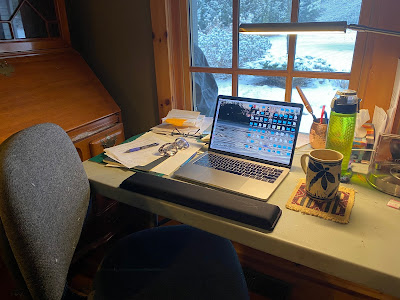I'm in the process, at last, of working on the book that came to me in a dream seven years ago. It has circled my head all these years, demanding I get at it. It's called: We're Not Done Yet: Coming to Art Later in Life.
It has actually hung in the air a couple of feet behind my head, attached by a string like a helium balloon, like a cartoon cloud, waiting for me to get to it. Some of you will know of it because I posted a request on Facebook in 2019 asking for artists who have come to art later in life to reply to me if they'd like to answer a questionnaire. I received 168 responses plus earlier interviews I did before the put out the questionnaire. There was some overlap, and some didn't respond after they'd offered to. All in all, I received 128 responses. By a huge majority it was women who responded to my questionnaire.
One thing about getting older is that there is a clear awareness that time is limited. I could tell myself when I was 50 that I was only half way through my life. Not now! Barbara, one of the women in a workshop I taught, worried that at this age, she was too old to change her subject matter in her painting. My own feeling is, why not spend the time left doing exactly what you want to do? Why not change? Why not let the work lead you to new worlds, new ways of seeing? We don't stop growing when we turn 50 or 65 or 92.
I had a woman in the same class named Dorothy Wilde who was 92 at the time. She came into the art class on a walker. Dorothy had been a very creative, playful and successful ceramicist for 40 years or more. As her strength faded, she gave up ceramics and took up printmaking. Here she was, in my painting class, delightedly learning another new skill. Dorothy was not at all afraid to play and experiment. She wasn't worried about making a product, about having an end result. She was there for the sheer enjoyment of making art. Her joy and playful abandon spread throughout the class.
Barbara decided to let go of trying to control the work, trying to keep it within the boundaries it had previously been confined within. Easy to try to control it. Difficult to surrender those boundaries. Inspired by Dorothy, in this class, Barbara went on to do some amazingly free work.
Creative successes late in life:
Although Canadian artist, Doris McCarthy began painting when she was young, it wasn't until she retired from teaching at 65 that her career began to take off. She graduated from the University of Toronto with a BA when she was 75, published her first memoir at 80, and the second 2 years later. She kept painting and having solo exhibitions until she was 95.
Louise Nevelson was in her 50's when she sold her work to three New York City museums and now her art can be seen internationally in over eighty public collections.
Laura Ingalls Wilder wrote about her family's life in the 1870's and 80's in the acclaimed, "The Little House on the Prairie" series of books for children, publishing her first book at the age of 65.
I loved reading the book called, " The Paper Garden: Mrs. Delany (begins her life's work) at 72", by Molly Peacock. At the age of 72, Mary Delany created a new art form; mixed-media collage and in the span of 10 years, she went on to create 985 botanically correct, cut-paper flowers, now at the British Museum.
My friend Marg Howe was a psychologist who published her first book at 100, a memoir of life as a recruiting psychologist in WW II. Her second book was published at 102, the story of life as a travelling psychologist in Ontario in the 50s and 60s.
“None are so old as those who have outlived enthusiasm.” ~Henry David Thoreau



Comments
Post a Comment